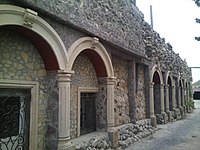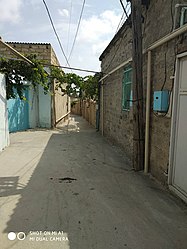
Quba District is one of the 66 districts of Azerbaijan. Located in the northeast of the country, it belongs to the Guba-Khachmaz Economic Region. The district borders the districts of Qusar, Qabala, Ismayilli, Shamakhi, Shabran, and Khachmaz. Its capital and largest city is Quba. As of 2020, the district had a population of 173,400.
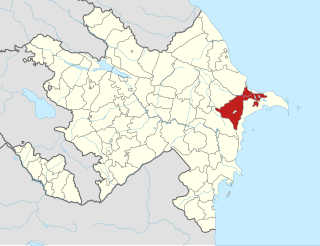
Absheron District is one of the 66 districts of Azerbaijan. Located in the east of the country, it belongs to the Absheron-Khizi Economic Region. The district borders the districts of Khizi, Gobustan, Baku, Hajigabul, Salyan, and the city of Sumgait. Its capital and largest city is Khyrdalan. As of 2020, the district had a population of 214,100. Although the district shares the same name as the Absheron Peninsula, the area covered by the district is not conterminous, being further west and mostly inland.

Qusar District is one of the 66 districts of Azerbaijan. It is located in the northeast of the country, in the Guba-Khachmaz Economic Region. The district borders the districts of Quba, Qabala, Khachmaz, and the Russian Republic of Dagestan. Its capital and largest city is Qusar. As of 2020, the district had a population of 99,000.
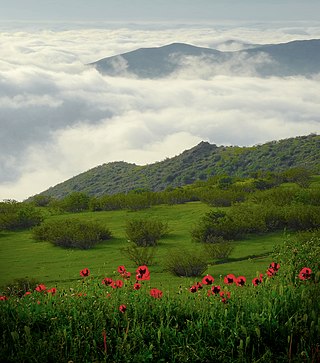
Shamkir District is one of the 66 districts of Azerbaijan. It is located in the north-west of the country and belongs to the Gazakh-Tovuz Economic Region. The district borders the districts of Gadabay, Tovuz, Samukh, Goygol, and Dashkasan. Its capital and largest city is Shamkir. As of 2020, the district had a population of 219,500.

Abbasgulu agha Bakikhanov, Abbas Qoli Bakikhanov, or Abbas-Qoli ibn Mirza Mohammad (Taghi) Khan Badkubi was an Azerbaijani writer, historian, journalist, linguist, poet and philosopher. He was son of the third khan of Baku Mirza Muhammad Khan II. Served as an officer in the Imperial Russian Army and participated in the Russo-Persian War of 1826–1828, he later retired and settled in Quba.
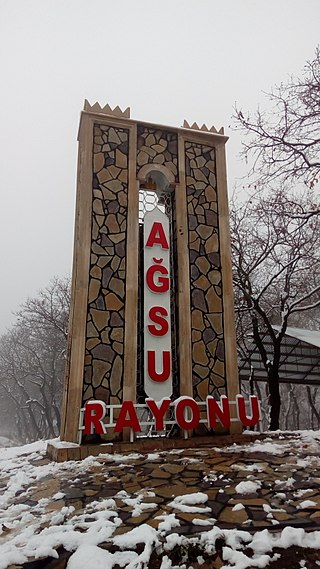
Agsu is a city in and capital of the Agsu District of Azerbaijan.

Bakıxanov is a settlement and municipality in Baku, Azerbaijan. It was named after Abbasgulu Bakikhanov and has a population of 71,600.

Əmircan is a municipality in Baku, Azerbaijan. It has a population of 28,203.

Quba is a city and the administrative centre of the Quba District of Azerbaijan. The city lies on the north-eastern slopes of Shahdag mountain, at an altitude of 600 metres above sea level, on the right bank of the Kudyal river. It has a population of 47,200 (2023).
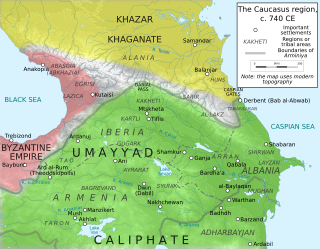
Arabs first established themselves in the Caucasus in the eighth century, during the Arab conquest of Persia. The process of shrinking of the Abbasid Caliphate in the tenth century was followed by the establishment of several Arab-ruled principalities in the region, chiefly the principality of Shirvan ruled by the Mazyadid dynasty. As the rulers of Shirvan spread their control over much of the Southeast Caucasus and at the same time found themselves more and more isolated from the Arab world, they were undergoing gradual Persianisation. Arab personal names of the Shirvanshahs gave way to Persian ones, members of the ruling dynasty were claiming Ancient Persian descent and Persian gradually became the language of the court and the urban population, while the rural population continued to speak the indigenous languages of Caucasian Albania. However by the seventeenth century a local Turkic idiom became the language of everyday life, as well as the language of interethnic communication.

The Gala State Historical Ethnographic Reserve is a complex of museums in Baku, Azerbaijan. Inside there are three different types of museums: Museum of Archaeology and Ethnography (open-air), Castle Museum, and the Museum of Antiques. Vehicles are offered to visitors due to the spacious area of museums. There are the tours in different languages: Azerbaijani, Russian, English, German and French.
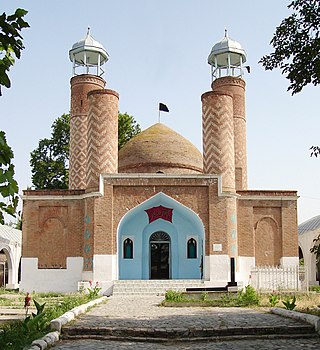
Imamzadeh Mausoleum is a monument which consists of a mausoleum and mosque, located in the center of Barda. The monument, which was the only 4 minarets built in Azerbaijan in the 14th century, was in the form of a pilgrimage-mausoleum, according to academician Dorn. A mosque was built around it in the 18th century.
Imamzadeh Mausoleum is mosque on the Imamli street in the central part of the city of Shamakhi. The mosque was registered by Ministry of Culture and Tourism of Azerbaijan Republic as a historical and cultural monument of the country.

The Nakhchivan Autonomous Republic is one of the touristic regions of Azerbaijan with its flora and fauna, climate, and ancient cultural monuments. Nakhchivan is known for its historical monuments such as Momuna Khatun, Yusif ibn Kuseyir, Gulustan tombs, and Garabaghlar. There are other touristic places like Babek castle, Kilit cave, Alinja castle, and Gamigaya in Nakhchivan.
The Bakikhanovs or Badkubehs are a Turkic noble family.
Muhammad Husayn Khan Mushtaq, was the third khan of Shaki. He was described as a courageous but ruthless man by Abbasgulu agha Bakikhanov.
Haji Khan or Haji Abdulaziz Khan was the fourth khan of Shaki. He was described as a brave and courageous, but extremely ruthless man by Azerbaijani historian Abbasgulu Bakikhanov.
Salim Khan was the sixth khan of Shaki. He was described as kind and joyful, but unmerciful man by Abbasgulu Bakikhanov.

The Gulistan-i Iram is a 19th-century Persian-language chronicle on the history of Shirvan, Dagestan, and Derbent from ancient times until the Treaty of Golestan concluded between the Russian Empire and Qajar Iran in 1813. It was composed in 1841 by Abbasgulu Bakikhanov, a 19th-century Tatar polymath who served under the Russian Empire. The name of the book is an allusion to the Garden of Iram mentioned in the Quran and the Gulistan village, where the treaty was concluded.

Absheron's stone roads, or cart roots of Absheron, are situated around the towns of Turkan, Hovsan, Nardaran, Dubandi, Qala, and Surakhani on the Absheron Peninsula in Azerbaijan.


